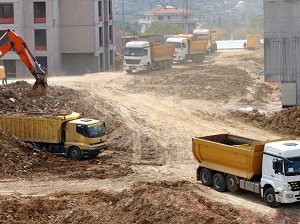Defensive driving isn’t just for public roads. It applies on every job site, whether workers are entering a construction zone, navigating a warehouse parking lot, driving through a residential area, or traveling to an isolated field location.

The potential for injury begins the moment a worker arrives at the job site, even before they exit their vehicle.
Hazards such as pedestrian traffic, blind corners, uneven surfaces, congested work areas, delivery trucks, and moving equipment can all contribute to vehicle-related incidents. Practicing defensive driving is the best way to prevent injuries, property damage, and collisions on the job.
Hazards Begin Before You Even Get Out of the Vehicle
Many workers assume hazards start once they begin work, but dangers exist even during arrival and movement around the site. Workers must be alert to:
- Changing surface conditions
- Confined or poorly marked access roads
- Narrow paths shared by equipment and pedestrians
- Blind spots created by parked vehicles or materials
- Congested areas or sudden equipment movement
- Workers on foot crossing travel paths
Driving slowly, scanning ahead, and anticipating hazards is key to maintaining safety from the moment the vehicle enters the site.
Safe Driving Practices for All Workers
Everyone on the job site must understand basic defensive driving principles, not just those operating work vehicles or heavy equipment. Safe driving habits help protect operators, spotters, pedestrians, subcontractors, and visitors.
Workers should:
- Drive cautiously and follow posted signs and barricades
- Maintain safe speeds appropriate for conditions
- Be alert for workers on foot and equipment entering travel paths
- Avoid distractions, including mobile devices
- Yield to larger equipment when appropriate
- Never assume others can see them or will stop
Backing incidents are especially dangerous when visibility is poor or workers fail to follow proper procedures. Most vehicle-related injuries on job sites involve reversing equipment.
Safety Meeting Topics for On-Site Driving
When holding a safety meeting about driving on the job site, be sure every worker, not only drivers, understands the following key points:
Use Only Designated Entrances and Access Points
Entrances and exits should be clearly marked and free of obstructions. Workers should avoid creating their own shortcuts or paths through active work areas.
Inspect Vehicles Before Use
Every vehicle, from company trucks to heavy equipment, must be inspected before operation. During a vehicle inspection, look for:
- Tire damage
- Fluid leaks
- Broken lights
- Non-functioning alarms
- Cracked windshields
- Missing mirrors
- Steering or brake issues
Ideally, job site vehicle inspections should be documented daily.
Report Hazards and Correct Defects Immediately
Any damage, mechanical defect, or faulty safety device must be reported and corrected before use. Workers must never operate a vehicle that is unsafe or poorly maintained.
Remove Defective Vehicles from Service
A vehicle with malfunctioning brakes, missing mirrors, a broken seat belt, or defective alarms must be taken out of service until properly repaired.
Vehicles Transporting Employees Must Have Proper Seating
Seats must be firmly secured and designed for the number of employees being transported. Workers must never ride on tailgates, equipment platforms, or unsecured areas.
Preventing Backing Incidents
Backing is one of the most common causes of job site vehicle injuries. Prevent backover incidents by:
- Ensuring back-up alarms are operational
- Checking the entire area behind the vehicle before reversing
- Never backing up unless you have a clear, unobstructed view
- Using a highly visible, well-trained spotter
- Maintaining constant communication with the spotter
- Stopping immediately if visual or radio contact is lost
Seat Belt Requirements and OSHA Standards
Seat belts save lives and are required for all vehicles and heavy equipment.
According to OSHA 1926.601(b) Vehicles used to transport employees shall have seats firmly secured and adequate for the number of employees to be carried. Seat belts and anchorages must be installed in all motor vehicles.
Workers should never operate or ride in any vehicle with a damaged, missing, or non-functional seat belt.

A Safer Job Site Begins with Defensive Driving
Defensive driving protects workers, equipment, and the public. By staying alert, following site rules, inspecting vehicles, wearing seat belts, and preventing backing incidents, crews can significantly reduce serious injuries related to vehicle movement.
When everyone on the job site understands, and practices, defensive driving, the entire work environment becomes safer and more controlled.
.jpeg)

.jpeg)